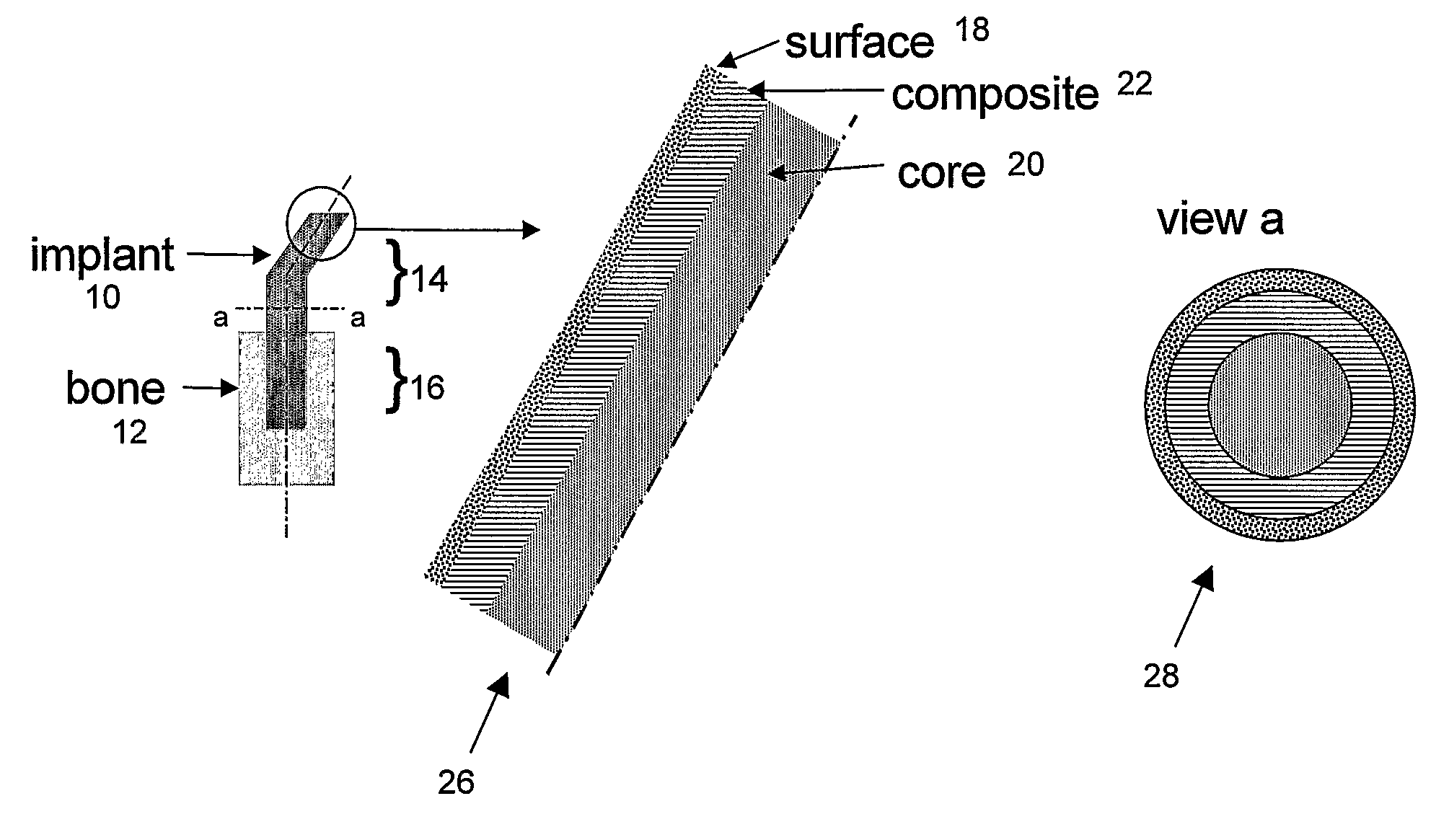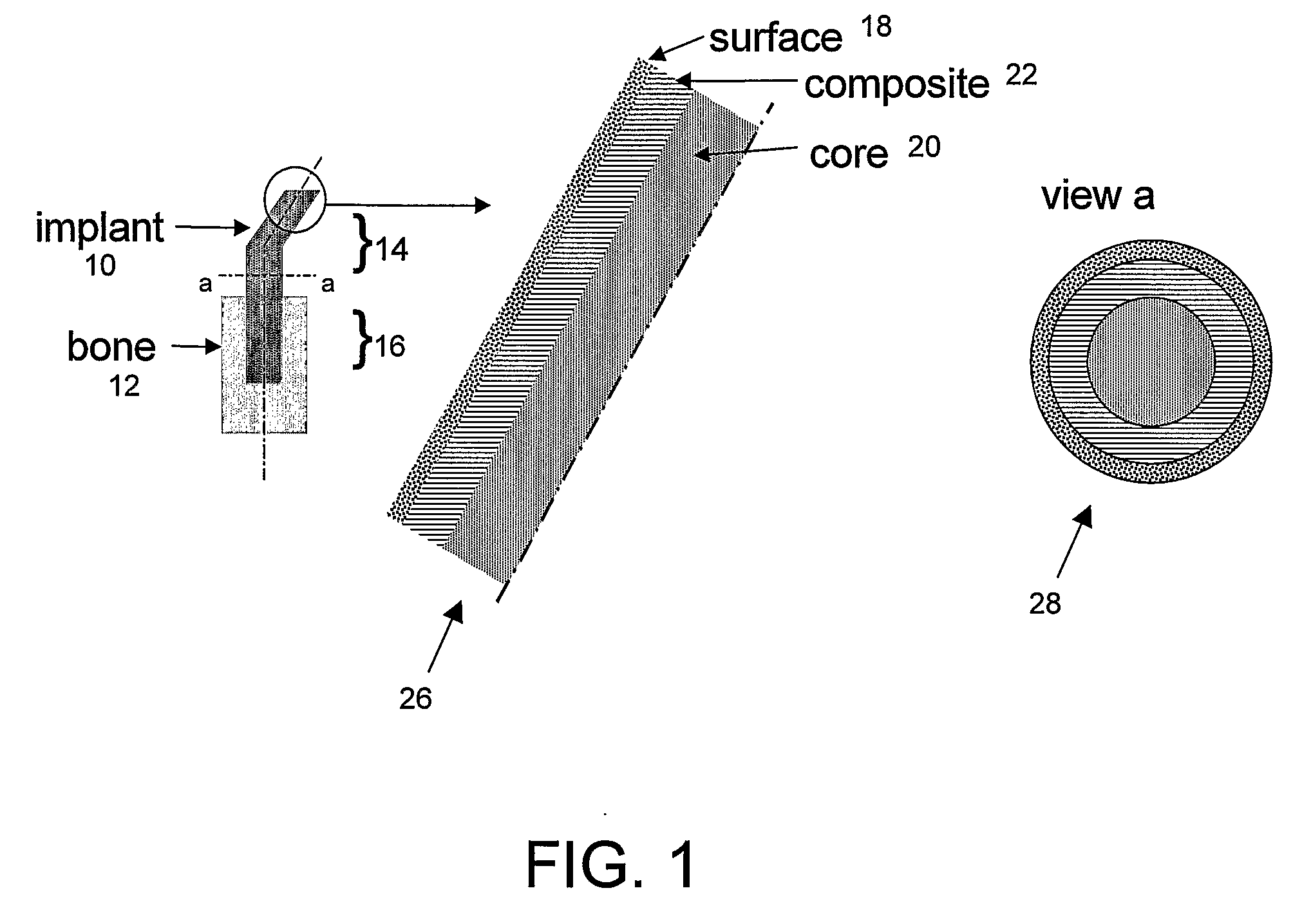Implantable biomimetic prosthetic bone
a biomimetic and prosthetic bone technology, applied in the field of implantable biomimetic composite prosthetic materials, can solve the problems of aseptic loosening, pain to the host, and clear inability to retrieve thp
- Summary
- Abstract
- Description
- Claims
- Application Information
AI Technical Summary
Benefits of technology
Problems solved by technology
Method used
Image
Examples
example 1
Total Hip Prosthesis (THP)
[0072]In this example, the inventive prosthetic bone according to the invention is a biomimetic THP stem.
[0073]FIG. 1 illustrates a prosthetic bone according to the invention, in this case formed as a THP stem or “implant” (10) to be implanted in hip replacement surgery, to be inserted in the femoral bone (12). The stem has an extra-osseous end (14) and an intra-osseous end (16). The surface (18) of the implant is designed so that fixation of the implant to the host tissue, either by adhesive bonding or by bone integration, allows a good stress transfer between the implant (10) and the bone (12) at any point along the implant (stem). At any point along the stem, its stiffness adjacent to the bone approximately matches that of the bone, making stresses in the bone and the stem approximately equal in the vicinity of the bone-stem interface. Section a..a illustrates the 3 layers: polymer-based core (20), fiber-reinforced thermoplastic composite (22) and surfac...
example 2
Fiber-Reinforced Composite
[0076]To illustrate the bone-matching properties of the composite, a CF / PA12 composite having 68 wt % long carbon fibers and 32 wt % polyamide 12 was compression-molded in different lay-up configurations (fiber orientations) and tested for flexural and interlaminar resistance using standard testing methodology (ASTM D790 / D2344). The results showed that, depending on the molding configuration, the moduli obtained ranged between 8 and 36 GPa and the mechanical strengths between 134 and 565 MPa. Thus the moduli which were obtained for a THP stem made of these composites correspond to those reported for dense bones (5-30 GPa). At the same time, the mechanical strength of these composite stems proved to be significantly above that of dense bones (100-200 MPa), showing that in extreme physiological conditions the composite stems of the invention would be subjected to stresses considerably below those leading to their failure. The latter property is advantageous b...
example 3
Bioactive HA Coating
[0078]To evaluate the feasibility of HA coatings of acceptable adhesion on the composite stems of the invention, flat coupons of CF / PA12 composite were prepared and coated by plasma spraying.
[0079]FIG. 2 illustrates an exemplary surface of HA coating on a CF / PA12 composite with a film interlayer. The film interlayer is composed of 25% vol. in HA particles (mean diameter of 30 μm) in a PA12 matrix. This layer was obtained by incorporating HA particles in a PA12 matrix using a twin screw extruder (TSE) and pelletizing the PA12 / HA compound. Then a 200-300 μm-thick film was produced from the pellets of this compound using a cast film line extruder. A composition of 25% (v / v) HA / PA12 for the compound was used. The film was then overmolded on the CF / PA12 composite cylindrical structures by inflatable bladder molding in a closed mold placed into a heated press. The resulting part was then coated with HA using plasma spray.
[0080]Results showed that an HA-filled polymer f...
PUM
| Property | Measurement | Unit |
|---|---|---|
| porosity | aaaaa | aaaaa |
| roughness | aaaaa | aaaaa |
| roughness | aaaaa | aaaaa |
Abstract
Description
Claims
Application Information
 Login to View More
Login to View More - R&D
- Intellectual Property
- Life Sciences
- Materials
- Tech Scout
- Unparalleled Data Quality
- Higher Quality Content
- 60% Fewer Hallucinations
Browse by: Latest US Patents, China's latest patents, Technical Efficacy Thesaurus, Application Domain, Technology Topic, Popular Technical Reports.
© 2025 PatSnap. All rights reserved.Legal|Privacy policy|Modern Slavery Act Transparency Statement|Sitemap|About US| Contact US: help@patsnap.com



